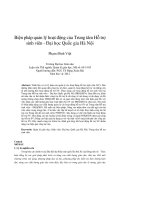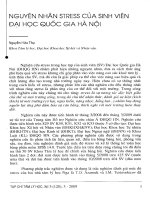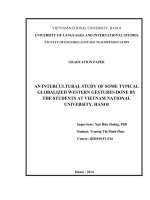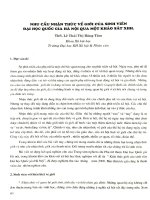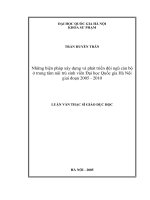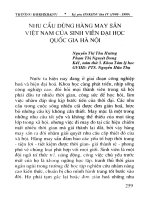MỘT NGHIÊN CỨU LIÊN VĂN HÓA VỀ VIỆC SỬ DỤNG MỘT SỐ CỬ CHỈ ĐẶC TRƯNG CÓ NGUỒN GỐC TỪ PHƯƠNG TÂY BỊ TOÀN CẦU HÓA CỦA SINH VIÊN ĐẠI HỌC QUỐC GIA HÀ NỘI
Bạn đang xem bản rút gọn của tài liệu. Xem và tải ngay bản đầy đủ của tài liệu tại đây (672.16 KB, 71 trang )
VIETNAM NATIONAL UNIVERSITY, HANOI
UNIVERSITY OF LANGUAGES AND INTERNATIONAL STUDIES
FACULTY OF ENGLISH LANGUAGE TEACHER EDUCATION
GRADUATION PAPER
AN INTERCULTURAL STUDY OF SOME TYPICAL
GLOBALIZED WESTERN GESTURES DONE BY THE
STUDENTS AT VIETNAM NATIONAL UNIVERSITY,
HANOI
Supervisor: Ngô Hữu Hoàng, PhD
Student: Trương Thị Minh Phúc
Course: QH2010.F1.E16
Hanoi - 2014
ĐẠI HỌC QUỐC GIA HÀ NỘI
TRƯỜNG ĐẠI HỌC NGOẠI NGỮ
KHOA SƯ PHẠM TIẾNG ANH
KHÓA LUẬN TỐT NGHIỆP
MỘT NGHIÊN CỨU LIÊN VĂN HÓA VỀ VIỆC SỬ DỤNG MỘT
SỐ CỬ CHỈ ĐẶC TRƯNG CĨ NGUỒN GỐC TỪ PHƯƠNG TÂY
BỊ TỒN CẦU HĨA CỦA SINH VIÊN ĐẠI HỌC QUỐC GIA
HÀ NỘI
Giáo viên hướng dẫn: Ngơ Hữu Hồng
Sinh viên: Trương Thị Minh Phúc
Khóa: QH2010.F1.E16
Hà Nội - 2014
ACEPTANCE
I hereby state that I: Truong Thi Minh Phuc, from group 10E16, English
Department, HULIS, being a candidate for the degree of Bachelor of Arts (TEFL)
accept the requirements of the College relating to the retention and use of Bachelor’s
Graduation Paper deposited in the library
In terms of these conditions, I agree that the origin of my paper deposited in the
library should be accessible for the purpose of study and research, in accordance with
the normal conditions established by the librarian for the care, loan or reproduction of
the paper.
Signature
Date: May 5 th 2014
i
ACKNOWLEDGEMENTS
First and foremost, I would like to express my sincere appreciation and my
deepest gratitude to my supervisor, Dr. Ngô Hữu Hoàng, for his precious guidance,
insightful comments, unconditional invaluable materials as well as his huge
encouragement from the initial to the final step for the accomplishment of this study.
Secondly, my big thank is extended to respectable lecturers of Faculty of English
Language Teacher Education in University of Languages and International Studies for
their motivation and devotion to every lesson during my four years at the university,
which inspired me a lot to write this paper. It is also my honor to say thank you to the
facilitation and frequent remind from the Department so that my study could be in
right process.
Then, I am in debt my profound thankfulness to my beloved family, my close
friends and my colleges who are always beside me, wholeheartedly count on me, give
me their constant supports and help me overcome difficulties.
Besides, I wish to thank the students at University of Languages and International
Studies, University of Economics and Business, University of Engineering and
Technology and International School, who enthusiastically participated in my data
collection process for their valid information. But for their assistances, I would not
have completed this paper.
After all, from the bottom of my heart, I would like to acknowledge all of those
who supported me in any respect during the completion of the study.
Truong Thi Minh Phuc
ii
ABSTRACT
The thesis completed by Trương Thị Minh Phúc, 10E16, ULIS-VNU, explores an
intercultural study on some typical globalized Western gestures done by the students at
Vietnam National University Hanoi
The research is conducted purposefully with the hope of clarifying how VNU students
use and perceive the finger gestures in general, five mentioned finger gestures (V-sign,
Thumb-up, OK sign, The middle finger and Beckoning) in particular among its various
global meanings. Moreover, the study is undertaken as an attempt to take a deeper
look at the tendency of using finger gestures in communicating of VNU students.
The method employed in this study is that of survey research which mainly are survey
questionnaire and observation. The investigation involves the participants of a hundred
students coming from four different universities of VNU responding to the thoroughly
designed questionnaire. Besides that, they are observed randomly and objectively for
the purpose of valid data. By figuring, calculating, combining, comparing and
generalizing, the data collected through research instruments is then analyzed carefully
and discussed in-depth, so that relevant and worthy findings can be found.
The results and findings of the study truly help to answer the research questions. It
allows the realization of the differences in using and perceiving finger gestures of the
students from four surveyed universities as well as the reflection of their attitude
towards using these finger gestures. Then, it also shows how much globalization has
effects on how VNU students practice the finger gestures in their communicating.
iii
TABLE OF CONTENTS
ACEPTANCE ……………………………………………………………………………..…i
ACKNOWLEDGEMENTS ……………………………………………………...................ii
ABSTRACT…………………………………………………………………………………..iii
TABLE OF CONTENTS……………………………………………………………………iv
ABRRIVIATION …………………………………………………………………………….v
LIST OF TABLES, CHARTS &FIGURES…………………………………….………….vi
PART A: INTRODUCTION
1. Rationale of the study…………………………………………………………………….1
2. Aims of the study and statement of research questions………………………………...2
3. Significance of the study………………………………………………………………….2
4. Scope of the study………………………………………………………………………...3
5. Design of the study………………………………………………………………………..4
PART B: DEVELOPMENT
CHAPTER 1: LITURATURE REVIEW……………………………………5
1.1.Theoretical background………………………………………………………………..5
1.1.1. Verbal and non-verbal communication ……………………………………………..5
1.1.1.1.Verbal communication………………………………………………………………7
1.1.1.2.Non-verbal communication ………………………………………………...............7
a. Gestures………………………………………………………………………….8
b. Origin and global meanings of the five listed finger gestures….........................9
i. “V” sign (Outward & inward)………………………………………………9
ii. OK sign……………………………………………………………………...10
iii. Thumb- up gesture ………………………………………………………….11
iv. The middle finger……………………………………………………………12
iv
v. Beckoning ………………………………….………………………………..14
1.2. Previous studies………………………………………………………………………...15
CHAPTER 2: METHODOLOGY…………………………………….……..17
2.1 Research instruments………………………………………………………………….17
2.2 Procedures of data collection………………………………………………………..18
2.3 Procedures of data analysis………………………………………………………....19
CHAPTER 3: THE STUDY………………………………………………..21
3.1. VNU students with finger gestures used in communicating……………………......21
3.1.1
The awareness of the finger gestures’ origins…………………………………..21
3.1.2
3.1.3
3.1.4
Evaluation on the role of using finger gestures in communicating.…………….22
The frequency of using the finger gestures in communicating ………………….24
The communicative partners with whom VNU students use the finger
gestures to talk……………………………………………………………………….25
3.2. VNU students with the five listed fingers in communicating……………..….……26
3.2.1. The awareness of the total five listed finger gestures……………………..…….....26
3.2.2. The awareness of the five listed finger gestures’ origins………………….27
3.2.3. The frequency of using the five listed finger gestures……………………………..28
3.3. VNU students perceive and employ the five listed finger gestures in their
communicating………………………………………………………………………29
3.3.1. “V” sign…………………………………………………………………………....29
3.3.2. OK sign………………………………………………………………………….....32
3.3.3. Thumb-up………………………………………………………………………..…33
3.3.4. The middle finger…………………………………………………………….. .......33
3.3.5. Beckoning…………………………………………………………………..……...34
PART C: CONCLUSION
1.
2.
3.
4.
Conclusions of the findings…………………………………………………………….37
Implications……………………………………………………………………………..38
Limitations of the study………………………………………………………………..39
Suggestions for further studies……………………………………………………......40
REFRENCES……………………………………………………………………………....41
APPENDIX…………………………………………………………………………………44
iv
iv
ABBREVIATIONS
VNU: Vietnam National University
ULIS: University of Languages and International Studies
UEB: University of Economics and Business
UET: University of Engineering and Technology
IS: International School
&: And
v
LIST OF TABLES, CHARTS & FIGURES
No
1
2
3
4
No
1
2
3
4
5
No
1
2
3
4
5
6
7
8
9
Tables
How often VNU students use finger gestures in communicating
Who VNU student use finger gestures to communicate with
VNU student’s notice of origins of some widely-used finger
gestures
The frequency of using five listed finger gestures by VNU students
Page
24
25
27
Charts
Notice of origins of finger gestures used in their conversations
How important using finger gestures in conversations is
VNU student’s awareness of the total five listed finger gestures
The awareness of differences in meanings between the two V-sign
gestures (inward & outward)
The awareness of differences in meanings of the two beckoning
gestures (upward & downward)
Page
21
23
26
30
Figures
Outward and inward V-sign
President Wilson Churchill (1874-1965)
OK sign
Thumb up
The middle finger
Beckoning
Outward and inward V-sign
Posing with outward and inward V-sign
Upward and downward beckoning
vi
28
35
Page
9
10
11
12
13
14
29
32
34
vi
PART A- INTRODUCTION
1. Rationale of the study
In the context of comprehensive integration and strong globalization as it is nowadays,
it is unavoidable that all aspects of human being’s life, especially in terms of culture
and communication are inevitably affected. Because intercultural communication is
encouraged and cultural differences among nations are reduced, the communication
styles of all countries are now being interacted. Vietnam- a country opening its door to
integrate wide-deeply into the world therefore cannot be out of the trend.
As a student learning foreign languages and international studies, in my point of view,
globalization has large effects on not only Vietnamese verbal but also non-verbal
communication. Then, its impacts on the non verbal cues seem to be important, owing
to its ability of proving intercultural features happened in the country for the time
being. Of many nonverbal cues, gestures used in conversations clearly reflect cultural
interactive features and play a significant role in communicating. Thanks to
globalization, Vietnam has chance to import and practice common gestures, most of
which originate from Western countries, in “Vietnamese way”. Interestingly, those
globalized gestures have been mainly absorbed by the young in general, the students in
cities in particular. The way that these specific gestures are used and perceived in
Vietnam has both similarities and differences with other cultures using the same signs.
Accounting for a large part of the gestures, finger gestures which do not originate from
Vietnam but are exotic gestures are used and appeared the most in conversations of the
young in Vietnam nowadays.
Aware of this context, I choose the topics “An Intercultural study of some typical
globalized Western
gestures
done
by
the
students
at
Vietnam
National
University, Hanoi” to study. Among the non-verbal cues often used when Vietnamese
13
young people are in touch, I focus on the some typical finger gestures, whose majority
is exotic, because it is the most noticeable signs.
2. Aims of the study and statement of research questions
Firstly, this research is conducted purposefully with the hope of helping VNU student
realize and enhance their knowledge about culture differences in general. Then, it also
provides the target students with a deeper look in the difference of meanings of the
five listed global finger gestures used in different cultures, especially in Vietnam.
Hence, VNU student is expected to be able to avoid culture- shock as well as be able
to use these ones appropriately in communicating with their partners. Moreover, the
study is undertaken as an attempt to help identify the communicating style and the
tendency of using finger gestures in communicating of VNU students. From that, the
researcher can partly suggest some solutions to help them communicate efficiently.
The research on some typical globalized Western gestures done by the student at
Vietnam National University Hanoi (VNU) focuses on clarifying some questions:
1. What are VNU students’ perceptions of using five listed finger gestures in
communicating?
2. How does globalization affect the use of some typical finger gestures done by
VNU students?
3. Significance
In my point of view, the research of some typical globalized Western gestures done by
the student at Vietnam National University, Hanoi is very interesting, useful and
practical. Finger gestures are very fascinating and diversified, and without them, our
speech would be static and colorless. In Vietnam, using finger gestures in
communication is more and more popular. Its density in conversations is getting higher
and higher and its efficiency in expressing emotions or reinforcing words is obvious.
14
Currently, communication culture of Vietnamese young people is attracting large
concern of society. The way they talk, interact; get in touch with others has
considerable effects on Vietnamese culture in general, on Vietnamese communicating
culture in particular. Especially, the way they use and perceive some typical globalized
Western finger gestures somehow shows the effects of globalization, mostly Western
cultures on Vietnamese young people’s communicating style as well as the
Vietnamizating process of these finger gestures of the young. Hence, the study helps to
clarify how strong globalization influences the way they communicate with others
using finger gesture and partly predict their communicating trends.
Besides that, once having been completed, the study would serve as one of the sources
providing us with an overview of the functions of finger gestures in communicating in
Vietnam nowadays; so that we can balance confused aspects of these gestures caused
by globalization. It means that we can diversify our communicating style by adapting
good features and avoid unsuitable ones. As a result, we can both enrich and protect
our culture uniqueness. Finally, it would be my pleasure if my humble piece of work
can be able to contribute to the development of research in the field of cultures
4. Scope of the study
Gesture, which is part of non- verbal cues, is a large aspect and it takes a lot of time
and effort to do research. As a result, it is very hard for the researcher to cover all
aspects of this issue. Additionally, due to time constraint, resources, the researcher’s
experience and knowledge, the research is set specific scope to study. Of many finger
gestures, these five ones: O.K” sign, Thumb-up gesture, The middle finger, “V”
gestures (outward& inward) and the beckoning gestures are the most widely used in
communicating in Vietnam by the young, especially the student. Therefore, the
primary focus of the study will be on these five finger gestures. Owning to some
objective and subjective reasons, the researcher decides to choose students of VNU as
the target participants to study. The researcher could not also deliver the questionnaire
15
for all students of VNU which has seven universities as members. Therefore, in the
most convenience, all the participants come from the four out of seven universities of
VNU: University of Languages and International Studies (ULIS), University of
Economics and Business (UEB), University of Engineering and Technology (UET)
and International school (IS)
5. Design of the study
In order to make it clear and easy to follow, the structure of the study is mainly divided
into following sections:
Part A: Introduction establishes the rationale of the study, the aims, the research
questions, the significance, the scope and the design of the study
Part B: Development- which includes three chapters:
•
Chapter 1: Literature Review points out some previous studies on the same
field, the comprehensive review of theoretical background on verbal
communication, nonverbal communications, the gestures and the origins as well
as its global meanings of the five listed finger gestures
•
Chapter 2: Methodology represents the selections of data collection
instruments, procedures of data collection and data analysis.
• Chapter 3: The study analyzes the data collected from informants to bring
about the findings and results that helps to answer the research questions.
Part C: Conclusion includes four sub parts such as conclusions of the findings,
implications, limitations of the study, and suggestions for further studies.
PART B – DEVELOPMENT
CHAPTER 1
16
LITERATURE REVIEW
1.1. Theoretical background
1.1.1. Verbal and non-verbal communication
Communication is one of the most important aspects in human beings’ life. Without
communication we cannot interact with the world and show them our view, our
expression. According to Beisler (1997), communication is “the transmission from one
person to another of a message which is understood by the receiver as the sender
intended” As Samovar and Porter (1991) put it “communication is complete only when
the intended behavior is observed by the intended receiver and that person responds to
and is affected by the behavior” In sum, communication is the transfer of information
from one person to another or others. It is evidently accepted that communication
consists of two common categories: verbal and non-verbal as Levine and Adelman
(1993) say: “Communication is the process of sharing meaning through verbal and
non-verbal behavior”
The definition above is supported diagrammatized by Nguyen Quang (2004:58)
17
18
1.1.1.1. Verbal communication
In Ronald D. Smith’s words, “Verbal communication occurs through written and
spoken words” (2005:142). In sum, verbal communication is an act of conveying
messages, ideas, or feelings through the use of mouth. Verbal communication is the
main way of communicating face-to-face. Among the key components of the verbal
communication are words, sound, speaking, and language. It is obvious that a specific
language assigns meanings to messages through a particular system of words.
Conventionally, verbal communication fulfills three main functions: (1) informing the
person of others’ thoughts and feelings, (2) stimulating the receiver of message by
triggering a response and (3) serving a descriptive function by imparting information
and sharing observations, ideas, inference and memories. (Watzalawick, et, al, 1967).
1.1.1.2. Non-verbal communication
When communicating, people not only use verbal cues but they also practice
nonverbal messages such as body languages, gestures, postures, etc in order to colorize
their conversations and show their expression lively. According to a research of
Mehrabian and Wiener (1972), only 7% of the speaker’s attitude is transmitted by
word, whereas 93% of the social meanings may be carried in actions or non-verbal
communication elements.
Non-verbal communication is the process of communication through sending and
receiving messages wordlessly. In other words, non- verbal communication includes
only the events, behaviors that we perceive and give meaning to, and it transcends
spoken or written words.
19
In fact the way of using non-verbal cues in communicating is not the same as other
countries; therefore, it is important to know some values of other cultures and so of
other ways of communicating for, first of all, avoiding some misunderstandings and
then knowing better some aspects of different cultures
a. Gestures
Among many non-verbal cues, gestures play a flagship role in communicating process.
Sometimes subtle gestures can express a feeling more graceful than words (Nancy
Armstrong &Melissa Wagner). “It is gestures that use us as their instruments, as their
bearers and incarnations”- Milan Kundera, Immortality (1991).
According to Do Mai Thanh & Dao Thu Trang (2006: 80) gestures, which are made
with a part of the body, especially hands, arms and fingers, are used to emphasize or
describe. It differs from physical non-verbal communication that does not
communicate specific messages, such as purely expressive displays, proxemics, or
displays of attention. It allows individuals to communicate a variety of feelings and
thoughts, from contempt and hostility to approval and affection, often together
with language in addition to words when they speak to reinforce. The gestures are not
clearly planned and no one is taught to use the gestures but everyone uses them. It may
simply add emphasis to audible messages, as when a speaker uses chopping motion of
the hand every time he or she stresses a word with the voice; or gestures may convey
more elaborate meanings to different observers, depending on the context of the
messages. As a matter of fact, the gestures have different meanings depending on the
circumstances and cultures and of course, they have specific connotations in certain
cultures.
Often, there are four general categories of gestures
•
•
•
Greeting gestures
Farewell gestures
Beckoning gestures
20
b.
• Insulting gestures
Origin and global meanings of the five listed finger gestures
i.
“V” sign (outward &inward)
Figure 1: Outward V-sign
Source:
Inward V-sign
/>
image4555172
Based on the view of the author of “Two fingers up to English history…” posted on
as well as other reliable sources [Verification Massey University,etc], the “V” sign was first used, as far as we know, by British
Longbowmen after winning the Battle of Agincourt in 1415. The French bowmen had
threatened to cut off the first two fingers – those that hold the arrow in place – of the
British bowmen. After the battle, the British archers flashed their first two fingers to
show that they were still intact; and it was used to mock the defeated French army. It is
the origin of “V” gesture with the palm facing toward the body. From the ideas of
historians collected from encyclopedia and specially Ranman of “Hands that carry
information” posted on the palm- out “V”
gesture is believed to be discovered by a Belgian lawyer named Victor De Lavelaye
21
who aimed to find a symbol that could be used for the international Nazi- resistance
movement in the 1940s as well as replaced for the letter “R.A.F” – used to insult the
Germans until that time. In order to achieve his aim and not to confuse international,
he came up with the letter “V” because it was not only the English word for “victory”
but also the Flemish and French.
In 1941 Winston Churchill made what we now know as the 'V-for-Victory sign'
famous. He made no distinction between the inward and outward V sign until the latter
part of the war when someone probably pointed out he was telling the masses to, "piss
off".
Figure 2: President Wilson Churchill (1874-1965)
Source: />In America and some Western countries, many people use the outward gesture as the
symbol of Victory or Peace, or simply say the number 2 and perceive the inward one
as insulting meanings. However, in Britain, Ireland or New Zealand, “V” signs (both
inward and outward) equal as “F**king”.
ii.
“OK” sign
22
There are many theories about the origin of the “O.K” sign. Firstly, in the 1830s there
was a rash of comic misspellings and shortened communications. For example, NG
commonly read to mean, “No go.”; SP meant “small potatoes”, and OK stood for “Oll
Korrect.” From other different source, OK is explained by a story that no soldier
(Zero- O) was reported killed (K) in the battle. In other words, it means “Everything is
fine”. Another theory is that the symbol represented American president Martin Van
Buren, often referred to as “Old Kinderhook.” Others say that French soldiers during
the American Revolution would invite girls to meet them “aux cayes,” down at the
docks. (Jamie Frater, 10 Symbols Whose Origins Have Been Forgotten, 2009)
In fact, many years underwent and now, this gesture is very popular all over the world
but it is not perceived in the same ways among countries.
Figure 3: OK sign
Source: />In some Western countries and America, the sign is to say that everything is “great”
“Alright!”, “fine”, “Let do it”, etc. In France, this gesture is read as “Zero” or
“Worthless”. Maybe not the message you want to convey in a French restaurant, if you
had a fine meal. Using this gesture in other cultures, Turkey for instance, you're saying
that the other person is gay. In Japan, on the hand, people use the “OK” sign to
indicate money. In Brazil, the circle that you make with your thumb and your index
23
finger can mean “asshole”, “You’re nothing”; it is even roughly equivalent to the
finger in the US. The example of this is when US President Nixon visited Brazil in the
1950′s. He got off the plane and gave the welcoming crowd a big “fuck you” and it
created a huge anger. Interestingly, in Thailand, Some say it's very offensive, while
others contend it's more childish than obscene, like sticking your tongue out.
iii.
Thumb-up gesture
According to Marquis Canaday- the author of “The origins of Thumbs up or down”
posted on his blog ( the genesis of thumbs up or down can be traced as
far back to ancient Rome, Egypt and Etruria, where it was well-known for the
gladiator – styled battles. In a bloody gladiator matches often occurring inside the
coliseums of Rome as amusement, the masses of people would linger for the life or
death indication by thumbing their finger up or down. Every so often, a thumbs up
would signal his death.
Figure 4: Thumb-up
Source: mentalfloss.com
In Western countries, The "Thumbs up", is generally accepted as a sign to show
someone that they've done well. In the US and part of Europe, hitch-hikers also use
24
this gesture to ask for a lift but with the hand extended right out so that people in cars
can see. In Australia, it means “Up yours!”
In many cultures putting your thumb up (especially when moving the hand up) is a
very rude gesture, similar to extending the middle finger for example in Nigeria. In the
Middle East, you give the thumbs-up sign with your thought of saying “"Ayyyyy! I'm
the fuckin' Fonz!", but the people here may receive your message as "Ayyyyy! I'm
going to jam my thumb in your anus!”
iv. The middle finger
This gesture is believed to be an insulting gesture and be one of the most popular ones
in the world. The middle finger is a phallus symbol, a sign mimicking a penis and
testicles. So where did the middle finger originate?
Figure 5: The middle finger
Source: />
25
